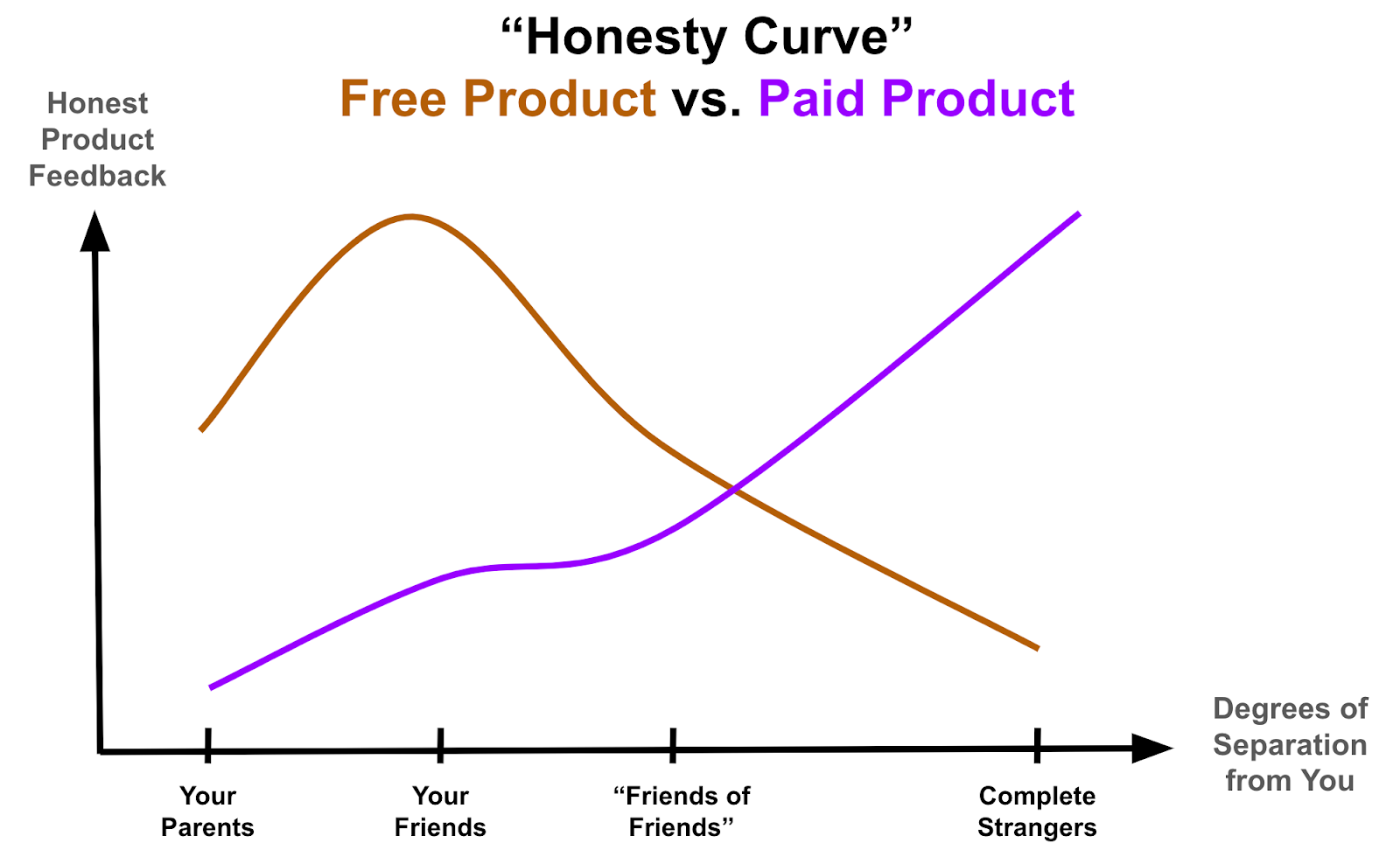Startup Course - Building Products, Communicating with Users, and Growth
The Wrong Way for Beginners to Start a Business
- Develop product in secret
- Hold an exclusive press conference!
- Wait for users
- Buy users (optional)
- Give up
Define the Problem Until You Can Clearly State It
- What problem are you solving?
- How does it relate to you?
- Verify if others have this problem too?
Where to Start
- Learn extensively, become an expert: You need to understand all aspects of the industry, become a part of it, and compete with people who have been working in the industry for over 15-20 years. You need to identify inefficient and costly parts of the industry process and try to provide solutions.
- Take HomeJoy founder Adora Cheung as an example, she chose to start in the cleaning industry, and they would personally do cleaning work, only to find out they weren't good at it;
- Buy books to learn about cleaning, understand cleaning tools and cleaning steps;
- Attend professional cleaning training courses at cleaning industry companies, and during the cleaning process at local cleaning companies, she discovered why local companies couldn't expand their services to more cities (traditional methods, poor scheduling, inefficient employee management).
- You need to become a member of the industry and observe your customers from multiple perspectives. You can learn all about your competitors online, but unfortunately, if you don't get involved personally, it's hard to find the breakthrough point to beat your competitors.
- Identify customer groups: You need to segment customer groups (gender, age, job, education)
- Map out the ideal user experience story:
- Not just the user's experience with the product, but also how users learn about you, whether through websites or word of mouth; how you deliver your message, how you communicate with customers;
- The entire user lifecycle experience from discovery, understanding, trial, commenting, abandoning, paying, returning, repurchasing, retention, customer support, to leaving;
- Transform all user experiences into paper or code, ultimately becoming the guiding principle of the product.
When you figure out the professional field, customer groups, and ideal user experience story, you should already know who your most important core users are.
Start Building the Product: What is v1?
- Minimum Viable Product: What is the smallest set of features you should build that can solve the problem?
- Simple Product Positioning: Product positioning is not just for yourself, there are definitely similar products in the market. You not only need to clearly understand the differences from market competitors, but your product positioning also needs to be simple enough for your users to understand through a few sentences.
- This is not the difficult part...
Initial Users (Starting from 0)
Yourself!
Your family, friends, and colleagues
Online communities, such as Hacker News, Reddit
Local communities, such as mailing lists
Niche influencers, such as bloggers, YouTubers
Cold calls + emails
News coverage
Street fairs
- You want to get more user feedback
- You need to actively seek customers, rather than waiting for them to come to you
- You need to go where potential customers are, attract them to book appointments and try your products and services (your success rate will definitely be very, very low, but going from 0 to 1, 2, 3, 4 is a process you must go through)
User Feedback (With Some Customers)
- support@ is very important: Users can contact you via support@youremail.com; if it's a phone, make sure you have a voicemail; your customers can find you and contact you.
- Surveys: Okay // Interviews: Better:
- It's better to proactively go out and communicate with customers, don't stay at your desk, you think it's a long journey, yes it is a long journey;
- But by going out, you can get the best user feedback on your product; this can tell you which features you need to completely modify, remove or build; send out surveys, proactively get product feedback after users experience the product;
- Note that only people who really like your product and really dislike your product will leave genuine user feedback; while the middle part of users can't give very real feedback;
- Avoid interrogation-style conversations, instead use communication that makes users feel comfortable;
- Quantitative: Retention rate, ratings, NPS:
- To get a macro perspective, tracking user retention rate is a good method, but it does take quite a long time to track data; get user ratings (0-5 points);
- Net Promoter Score (NPS) How likely are users to recommend our company/product/service to friends or colleagues? (0-10 points, promoters 9-10 points, neutrals 7-8 points, detractors 0-6 points) NPS = % of promoters - % of detractors, score range from -100 to +100
- Qualitative: Ask why, why, why: Understand the reasons behind user feedback
- Pay attention to the honesty curve

v1 Feature Launch
- Build quickly, but optimize manually before automating: Premature automation may not help you build a more efficient process, but rather overlook important details and things, leading to a lack of understanding of product value and customer satisfaction.
- Temporary failures > Permanent paralysis: Perfection is irrelevant at this stage. So there's no need to focus on all details and scenarios, focus on the most core user cases. Wait until individual cases increase to become almost mainstream user cases before solving them.
- Beware of becoming Frankenstein:
- Don't accept every customer's demands, sometimes some features are unreasonable and inconsistent with the product concept;
- The issues we need to focus on are, for example, I have other problems I need you to build for me to use in the product process, or I need you to solve this problem before I can start paying for the product;
- Find these important issues, rather than stitching together all user-requested features (hiding all important issues behind).
S (stealth) stands for stealth, and also for stupidity
Someone will steal your ideas, There's an advantage to being first ...hurry up and launch it
Open product
Are you ready for a large number of users?
- Learn one channel at a time,
- You may be attracted to the idea of trying 5 different promotion channel strategies simultaneously, but avoid doing so;
- Since you are typically a one-person growth team, you should choose one promotion channel strategy to fully execute for an entire week, focus on it, and conduct a detailed post-analysis of its effectiveness; summarize the reasons for success or failure, gain experience, and continuously iterate on promotion strategies and practices;
- If the chosen promotion channel strategy is extremely effective, you should execute it until it reaches its limit; if it's ineffective, switch to another;
- Iterate on effective channels,
- All promotion channels change, so you must constantly vary your promotion channels and methods;
- Evaluate promotion channels well
- Revisit failed channels
- If you failed when trying initially, you can switch to other channels, as there are many things to try
- After some time, don't forget to go back to these previously failed channels and test again
Key = Creativity: In marketing, you need technical skills, but you also need creativity. If marketing were very simple, everyone would be growing now. You always have to find something special that no one has done before and do it to the extreme.
Growth Types
- Sticky Growth: Get your existing users to come back and pay more or use your service more.
- Viral Growth: Users are willing to talk about you, users use the product (product has built-in sharing attributes), willing to tell 10 friends.
- Paid Growth: If you have enough funds, you can spend some money to buy growth.
Key = Sustainability: The key to achieving sustainable growth is to reduce losses, and your investment of money and time has a good return on investment.
Sticky Growth
- Good experience wins: Deliver addictive product and service experiences
- Customer Lifetime Value + Retention Cohort Analysis are important
- Repeat users buy more and more

For example, we identified a customer segment and chose month as the analysis unit for Cohort Analysis. The vertical axis represents user retention rate, and the horizontal axis represents time. As time increases, our user retention forms a downward curve. Initially, we have 100% of users. If our user retention drops to 0 after the first month, this is certainly not a good business. Our goal is to make the final process of users higher and higher, that is, to push the curve towards the upper right.
On this curve, who are our core users? We should notice that as time goes on, our curve will eventually not fluctuate much, with a growth rate close to 0%. In this case, the remaining users are our core users. We need to maintain our core users while continuing to increase the growth rate, until it returns to 0% again, then try to increase it again. Fluctuations can occur, but negative growth should be avoided.
Customer Lifetime Value: The value a user brings to the company over a period of time. This value can be measured by 12 months of revenue, net profit, or 3 months, 6 months of time.
Cohort Analysis: Cohort is similar to the concept of user segmentation. You can choose cohorts like female users vs male users, first-tier city users vs third and fourth-tier city users. The most commonly used is segmentation by time (for example, calculating monthly).
Viral Growth
The foundation for achieving viral growth is:
- Absolutely amazing product experience (making users willing to share on their social media)
- Excellent referral program (users are willing to share you, but what content should users share, and how to make referrals conveniently)
Referral program:
- Customer touch points: Where do users learn that they can recommend to others? (For example, after they subscribe; after they register; when users have been using the product for a while and they use it frequently; when you have the opportunity to interact with users and you can leave something for them, you can tell them and provide relevant materials or information;)
- Program mechanics: Users will receive rewards (such as $10) for successful referrals, you can try different reward methods and find the most effective one, just like you do with promotional channels (or this is also part of promotional channels);
- Referral conversion flow: When someone enters through a referral link, be sure to provide a clear conversion process experience, how they register and other information, try more upsell opportunities;
Paid Growth
- Search Engine Marketing (SEM)
- Display ads
- Facebook ads
- Groupon/daily deals
- Street marketing
- B2B sales
- Direct mailers
Evaluation criteria for paid growth:
- Simple formula (overall advertising effectiveness): CLV (Customer Lifetime Value) > CAC (Customer acquisition cost)
- More advanced formula (for evaluating individual ads or different user segments):

CAC = CPC/Conversion
Customer Acquisition Cost = Cost Per Click / Conversion Rate

- Essential criteria: Payback time + Sustainable revenue
For example, if you spend $200 in advertising costs to acquire a user (with a 12-month CLV of $300), but the user only pays $100 in the first month. This means you're currently at a $100 loss. And you can't be certain that you'll earn the remaining $200, because you don't know if the user might leave for some reason, so the remaining $200 is not sustainable revenue.
The payback time should ideally be within 3 months; if it exceeds 12 months, it becomes risky.
P.S: This somewhat explains why many companies are willing to offer discounts for users who pay for a full year upfront, as it effectively reduces the payback time to the moment the user clicks the payment button.
The Art of Pivoting
When will you encounter many choices, when do you abandon a project to seek a new one? When should you give up?
Three judgment methods:
- Poor growth: The project cannot gain traction
- Low retention rate: Even if you reach many users, no users are willing to stay
- Poor economic benefits: The project cannot be profitable
Among them, the judgment of growth is relatively difficult to recognize, 🌰 because some founders have invested in a project for 3 years, and it suddenly takes off after three years.
You should have a growth plan before starting a project. What is an optimistic but realistic way for your project to develop? What is your estimated exponential growth point in terms of user numbers, and how long will it take you to reach that point? You need to have estimates and calculations, clearly understanding the future development and growth plan of the project.

For example, if you have no growth for 3-4 consecutive weeks, then you may need to pivot.
Theoretically, the growth curve is a smooth curve, but in reality, you will get a winding line. You need to ensure that you don't give up every time users decline, which is why you should extend the time to judge growth to 3-4 weeks or even longer. The length of time for judgment should be determined based on the industry.
Q&A
How to acquire users who are already using similar products/services?
You need to identify situations where your product/service is better than similar ones, or where you can meet certain needs that other similar products/services cannot fulfill. Use this as a breakthrough point to make users realize the excellence of your product/service and decide to continue using it.
Additionally, you can't tell customers, "My product is superior in over 50 ways compared to others." Because average users won't calculate those 50 points and know if it outweighs the cost of switching services (i.e., if the total benefit of switching is higher). So it's best to highlight just 1 or 2 points that can demonstrate your difference and persuade customers.
Resource
- Lecture 4 - Building Product, Talking to Users, and Growing (Adora Cheung, Homejoy 创始人): https://youtu.be/yP176MBG9Tk?si=8rgNTMznu4E7sDs6